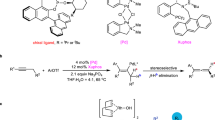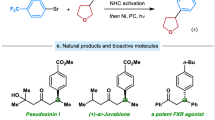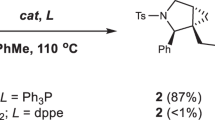Abstract
Understanding how catalytic asymmetric reactions with racemic starting materials can operate would enable new enantioselective cross-coupling reactions that give chiral products. Here we propose a catalytic cycle for the highly enantioselective Rh(i)-catalysed Suzuki–Miyaura coupling of boronic acids and racemic allyl halides. Natural abundance 13C kinetic isotope effects provide quantitative information about the transition-state structures of two key elementary steps in the catalytic cycle, transmetallation and oxidative addition. Experiments with configurationally stable, deuterium-labelled substrates revealed that oxidative addition can happen via syn- or anti-pathways, which control diastereoselectivity. Density functional theory calculations attribute the extremely high enantioselectivity to reductive elimination from a common Rh complex formed from both allyl halide enantiomers. Our conclusions are supported by analysis of the reaction kinetics. These insights into the sequence of bond-forming steps and their transition-state structures will contribute to our understanding of asymmetric Rh–allyl chemistry and enable the discovery and application of asymmetric reactions with racemic substrates.

This is a preview of subscription content, access via your institution
Access options
Access Nature and 54 other Nature Portfolio journals
Get Nature+, our best-value online-access subscription
$29.99 / 30 days
cancel any time
Subscribe to this journal
Receive 12 digital issues and online access to articles
$119.00 per year
only $9.92 per issue
Buy this article
- Purchase on Springer Link
- Instant access to full article PDF
Prices may be subject to local taxes which are calculated during checkout







Similar content being viewed by others
Data availability
Detailed experimental methods and analytical data for all the experiments, along with absolute energies and selected distances for the DFT-computed structures and for the computed stationary points, can be found in the Supplementary Information. Cartesian coordinates (in xyz format) for the computed stationary points can be found in the Supplementary Data.
Code availability
All Python scripts used for the data analysis have been made available at https://github.com/bobbypaton under a creative commons CC-BY license.
References
Hall, D. G. Boronic Acids: Preparation and Applications in Organic Synthesis and Medicine (Wiley-VCH, 2006).
Suzuki, A. Cross-coupling reactions of organoboranes: an easy way to construct C–C bonds (Nobel Lecture). Angew. Chem. Int. Ed. 50, 6722–6737 (2011).
Cherney, A. H., Kadunce, N. T. & Reisman, S. E. Enantioselective and enantiospecific transition-metal-catalyzed cross-coupling reactions of organometallic reagents to construct C–C bonds. Chem. Rev. 115, 9587–9652 (2015).
Dong, L. et al. Asymmetric nitroallylation of arylboronic acids with nitroallyl acetates catalyzed by chiral rhodium complexes and its application in a concise total synthesis of optically pure (+)-γ-lycorane. Org. Lett. 7, 4285–4288 (2005).
Yu, B., Menard, F., Isosno, N. & Lautens, S. Synthesis of homoallylic alcohols via Lewis acid assisted enantioselective desymmetrization. Synthesis 2009, 853–859 (2009).
Shintani, R., Takatsu, K., Takeda, M. & Hayashi, T. Copper-catalyzed asymmetric allylic substitution of allyl phosphates with aryl- and alkenylboronates. Angew. Chem. Int. Ed. 50, 8656–8659 (2011).
Zhang, P., Brozek, L. A. & Morken, J. P. Pd-catalyzed enantioselective allyl–allyl cross-coupling. J. Am. Chem. Soc. 132, 10686–10688 (2010).
Chung, K., Miyake, Y. & Uemura, S. Nickel(0)-catalyzed asymmetric cross-coupling reactions of allylic compounds with Grignard reagents using optically active oxazolinylferrocenylphosphines as ligands. J. Chem. Soc. Perkin Trans. 1 2000, 2725–2729 (2000).
Ohmiya, H., Makida, Y., Tanaka, T. & Sawamura, M. Palladium-catalyzed γ-selective and stereospecific allyl−aryl coupling between allylic acetates and arylboronic acids. J. Am. Chem. Soc. 130, 17276–17277 (2008).
Ohmiya, H., Yokokawa, N. & Sawamura, M. Copper-catalyzed gamma-selective and stereospecific allyl–aryl coupling between (Z)-acyclic and cyclic allylic phosphates and arylboronates. Org. Lett. 12, 2438–2440 (2010).
Sidera, M. & Fletcher, S. P. Rhodium-catalyzed asymmetric allylic arylation of racemic halides with arylboronic acids. Nat. Chem. 7, 935–939 (2015).
Schäfer, P., Palacin, T., Sidera, M. & Fletcher, S. P. Asymmetric Suzuki–Miyaura coupling of heterocycles via rhodium-catalyzed allylic arylation of racemates. Nat. Commun. 8, 15762 (2017).
González, J., van Dijk, L., Goetzke, F. W. & Fletcher, S. P. Highly enantioselective rhodium-catalyzed cross-coupling of boronic acids and racemic allyl halides. Nat. Protocols 14, 2972–2985 (2019).
Goetzke, F. W., Mortimore, M. & Fletcher, S. P. Enantio- and diastereoselective Suzuki–Miyaura coupling with racemic bicycles. Angew. Chem. Int. Ed. 58, 12128–12132 (2019).
Hayashi, T., Takahashi, M., Takaya, Y. & Ogasawara, M. Catalytic cycle of rhodium-catalyzed asymmetric 1,4-addition of organoboronic acids. Arylrhodium, oxa-π-allylrhodium, and hydroxorhodium intermediates. J. Am. Chem. Soc. 124, 5052–5058 (2002).
Kina, A., Iwamura, H. & Hayashi, T. A kinetic study on Rh/binap-catalyzed 1,4-addition of phenylboronic acid to enones: negative nonlinear effect caused by predominant homochiral dimer contribution. J. Am. Chem. Soc. 128, 3904–3905 (2006).
Jacobsen, E. N., Pfaltz, A. & Yamamoto, H. Comprehensive Asymmetric Catalysis II (Springer, 1999).
Turnbull, B. W. H. & Evans, P. A. Asymmetric rhodium-catalyzed allylic substitution reactions: discovery, development and applications to target-directed synthesis. J. Org. Chem. 83, 11463–11479 (2018).
You, H., Rideau, E., Sidera, M. & Fletcher, S. P. Non-stabilized nucleophiles in Cu-catalyzed dynamic kinetic asymmetric allylic alkylation. Nature 517, 351–355 (2015).
Rideau, E., You, H., Sidera, M., Claridge, T. D. W. & Fletcher, S. P. Mechanistic studies on a Cu-catalyzed asymmetric allylic alkylation with cyclic racemic starting materials. J. Am. Chem. Soc. 139, 5614–5624 (2017).
Lu, Z., Wilsily, A. & Fu, G. C. Stereoconvergent amine-directed alkyl–alkyl Suzuki reactions of unactivated secondary alkyl chlorides. J. Am. Chem. Soc. 133, 8154–8157 (2011).
Gutierrez, O., Tellis, J. C., Primer, D. N., Molander, G. A. & Kozlowski, M. C. Nickel-catalyzed cross-coupling of photoredox-generated radicals: uncovering a general manifold for stereoconvergence in nickel-catalyzed cross-couplings. J. Am. Chem. Soc. 137, 4896–4899 (2015).
Langlois, J., Emery, D., Mareda, J. & Alexakis, A. Mechanistic identification and improvement of a direct enantioconvergent transformation in copper-catalyzed asymmetric allylic alkylation. Chem. Sci. 3, 1062–1069 (2012).
Girard, C. & Kagan, H. B. Nonlinear effects in asymmetric synthesis and stereoselective reactions: ten years of investigation. Angew. Chem. Int. Ed. 37, 2922–2959 (1998).
Tsui, G. C., Menard, F. & Lautens, M. Regioselective rhodium(i)-catalyzed hydroarylation of protected allylic amines with arylboronic acids. Org. Lett. 12, 2456–2459 (2010).
Yang, Q., Wang, Y., Luo, S. & Wang, J. Kinetic resolution and dynamic kinetic resolution of chromene by rhodium-catalyzed asymmetric hydroarylation. Angew. Chem. Int. Ed. 58, 5343–5347 (2019).
Yang, X. et al. Catalytic hydrothiolation: counterion-controlled regioselectivity. J. Am. Chem. Soc. 141, 3006–3013 (2019).
Mc Daniel, D. H. & Brown, H. C. An extended table of Hammett substituent constants based on the ionization of substituted benzoic acids. J. Org. Chem. 23, 420–427 (1958).
Corrie, T. J. A., Ball, L. T., Russell, C. A. & Lloyd‐Jones, G. C. Au-catalyzed biaryl coupling to generate 5- to 9-membered rings: turnover-limiting reductive elimination versus π-complexation. J. Am. Chem. Soc. 139, 245–254 (2017).
Lennox, A. J. J. & Lloyd‐Jones, G. C. Transmetalation in the Suzuki–Miyaura coupling: the fork in the trail. Angew. Chem. Int. Ed. 52, 7362–7370 (2013).
Thomas, A. A. & Denmark, S. E. Pre-transmetalation intermediates in the Suzuki–Miyaura reaction revealed: the missing link. Science 352, 329–332 (2016).
Yaman, T. & Harvey, J. N. Suzuki–Miyaura coupling revisited: an integrated computational study. Faraday Discuss. 220, 425–442 (2019).
Singleton, D. A. & Thomas, A. A. High-precision simultaneous determination of multiple small kinetic isotope effects at natural abundance. J. Am. Chem. Soc. 117, 9357–9358 (1995).
Frantz, D. E., Singleton, D. A. & Snyder, J. P. 13C kinetic isotope effects for the addition of lithium dibutylcuprate to cyclohexenone. Reductive elimination is rate-determining. J. Am. Chem. Soc. 119, 3383–3384 (1997).
Li, J. et al. Catalytic asymmetric cascade vinylogous Mukaiyama 1,6-Michael/Michael addition of 2-silyloxyfurans with azoalkenes: direct approach to fused butyrolactones. J. Am. Chem. Soc. 137, 10124–10127 (2015).
Colletto, C., Islam, S., Juliá-Hernández, F. & Larrosa, I. Room-temperature direct β-arylation of thiophenes and benzo[b]thiophenes and kinetic evidence for a Heck-type pathway. J. Am. Chem. Soc. 138, 1677–1683 (2016).
Smith, J. R. et al. Enantioselective rhodium(iii)-catalyzed Markovnikov hydroboration of unactivated terminal alkenes. J. Am. Chem. Soc. 139, 9148–9151 (2017).
Rathbun, C. M. & Johnson, J. B. Rhodium-catalyzed acylation with quinolinyl ketones: carbon−carbon single bond activation as the turnover-limiting step of catalysis. J. Am. Chem. Soc. 133, 2031–2033 (2011).
Moore, J. L., Silvestri, A. P., de Alaniz, J. R., DiRocco, D. A. & Rovis, T. Mechanistic investigation of the enantioselective intramolecular Stetter reaction: proton transfer is the first irreversible step. Org. Lett. 13, 1742–1745 (2011).
Lee, D. H., Kwon, K. H. & Yi, C. S. Selective catalytic C–H alkylation of alkenes with alcohols. Science 333, 1613–1616 (2011).
Meyer, M. P. New Applications of Isotope Effects in the Determination of Organic Reaction Mechanisms (Elsevier, 2012).
Vo, L. K. & Singleton, D. A. Isotope effects and the nature of stereo- and regioselectivity in hydroaminations of vinylarenes catalyzed by palladium(ii)−diphosphine complexes. Org. Lett. 6, 2469–2472 (2004).
Roytman, V. A., Karugu, R. W., Hong, Y., Hirschi, J. S. & Vetticatt, M. J. 13C kinetic isotope effects as a quantitative probe to distinguish between enol and enamine mechanisms in aminocatalysis. Chem. Eur. J. 24, 8098–8102 (2018).
Wolfsberg, M., Van Hook, W. A., Paneth, P. & Rebelo, L. P. N. Isotope Effects in the Chemical, Geological, and Bio Sciences (Springer, 2010).
Simmons, E. M. & Hartwig, J. F. On the interpretation of deuterium kinetic isotope effects in C–H bond functionalizations by transition-metal complexes. Angew. Chem. Int. Ed. 51, 3066–3072 (2012).
Deb, A., Hazra, A., Peng, Q., Paton, R. S. & Maiti, D. Detailed mechanistic studies on palladium-catalyzed selective C−H olefination with aliphatic alkenes—a significant influence of proton shuttling. J. Am. Chem. Soc. 139, 763–775 (2017).
Mekareeya, A. et al. Mechanistic insight into palladium-catalyzed cycloisomerization: a combined experimental and theoretical study. J. Am. Chem. Soc. 139, 10104–10114 (2017).
Frisch, M. J. et al. Gaussian 09, Revision D.01 (Gaussian, 2009).
Straker, R., Peng, Q., Mekareeya, A., Paton, R. S. & Anderson, E. A. Computational ligand design in enantio- and diastereoselective ynamide [5+2] cycloisomerizations. Nat. Commun. 7, 10109 (2016).
Peng, Q., Duarte, F. & Paton, R. S. Computing organic stereoselectivity—from concepts to quantitative calculations and predictions. Chem. Soc. Rev. 45, 6093–6107 (2016).
Karabiyikoglu, S., Brethomé, A., Palacin, T., Paton, R. S. & Fletcher, S. P. Enantiomerically enriched tetrahydropyridine allyl chlorides. Chem. Sci. 11, 4125–4130 (2020).
Mackenzie, P. B., Whelan, J. & Bosnich, B. Asymmetric synthesis. Mechanism of asymmetric catalytic allylation. J. Am. Chem. Soc. 107, 2046–2054 (1985).
Lloyd‐Jones, G. C. & Stephen, S. C. Memory effects in Pd‐catalysed allylic alkylation: stereochemical labelling through isotopic desymmetrization. Chem. Eur. J. 4, 2539–2549 (1998).
Lloyd‐Jones, G. C. et al. Conclusive evidence for a retention−retention pathway for the molybdenum-catalyzed asymmetric alkylation. J. Am. Chem. Soc. 126, 702–703 (2004).
Madrahimov, S. T. & Hartwig, J. F. Origins of enantioselectivity during allylic substitution reactions catalyzed by metallacyclic iridium complexes. J. Am. Chem. Soc. 134, 8136–8147 (2012).
Granberg, K. L. & Bäckvall, J. E. Isomerization of (π-allyl)palladium complexes via nucleophilic displacement by palladium(0). A common mechanism in palladium(0)-catalyzed allylic substitution. J. Am. Chem. Soc. 114, 6858–6863 (1992).
Falivene, L. et al. Towards the online computer-aided design of catalytic pockets. Nat. Chem. 11, 872–879 (2019).
Acknowledgements
The EPSRC supports this work though standard grant EP/N022246/1. L.v.D. and R.A. thank the EPSRC Centre for Doctoral Training (CDT) in Synthesis for Biology and Medicine (EP/L015838/1) for studentships, generously supported by AstraZeneca, Diamond Light Source, Defence Science and Technology Laboratory, Evotec, GlaxoSmithKline, Janssen, Novartis, Pfizer, Syngenta, Takeda, UCB and Vertex. R.A. also acknowledges the Development and Promotion of Science and Technology Talents Project and the Royal Thai Government. This material is based on work supported by the National Science Foundation under Grant no. 1955876. We used the Dirac cluster at Oxford supported by the EPSRC CDT for Theory and Modelling in Chemical Sciences (EP/L015722/1), the RMACC Summit supercomputer, which is supported by the National Science Foundation (ACI-1532235 and ACI-1532236), the University of Colorado Boulder and Colorado State University, and the Extreme Science and Engineering Discovery Environment (XSEDE) through allocation TG-CHE180056 and computing resources provided by the National e-Science Infrastructure Consortium, Thailand. O.S. thanks the Scientific and Technological Research Council of Turkey for the 2214-A Scholarship Programme. The research leading to these results has received funding from the European Research Council under the European Union’s Seventh Framework Programme (FP7/2007-2013)/ERC grant agreement no. [838616].
Author information
Authors and Affiliations
Contributions
S.P.F. conceived and directed the project. S.P.F., L.v.D. and M.S. designed the experiments. L.v.D., M.S. and S.K. performed the experiments. L.v.D., R.A., M.S., R.S.P., G.C.L.-J. and S.P.F. analysed the experimental results. R.S.P, L.v.D., R.A. and O.S. designed, conducted and analysed the computational work. T.D.W.C. designed and performed the 13C NMR experiments. G.C.L.-J. derived the pseudo steady-state rate equation. L.v.D. and S.P.F. wrote the manuscript with contributions from R.S.P., G.C.L.-J., T.D.W.C., M.S. and R.A.
Corresponding authors
Ethics declarations
Competing interests
The authors declare no competing interests.
Additional information
Peer review information Nature Catalysis thanks Per-Ola Norrby and the other, anonymous, reviewer(s) for their contribution to the peer review of this work.
Publisher’s note Springer Nature remains neutral with regard to jurisdictional claims in published maps and institutional affiliations.
Supplementary information
Supplementary Information
Supplementary Figs. 1–8, Tables 1–26, Methods, Discussion and References.
Supplementary Data
Co-ordinates of computed structures in xyz format.
Rights and permissions
About this article
Cite this article
van Dijk, L., Ardkhean, R., Sidera, M. et al. Mechanistic investigation of Rh(i)-catalysed asymmetric Suzuki–Miyaura coupling with racemic allyl halides. Nat Catal 4, 284–292 (2021). https://doi.org/10.1038/s41929-021-00589-y
Received:
Accepted:
Published:
Issue Date:
DOI: https://doi.org/10.1038/s41929-021-00589-y
This article is cited by
-
Chelation enables selectivity control in enantioconvergent Suzuki–Miyaura cross-couplings on acyclic allylic systems
Nature Chemistry (2024)
-
Cobalt(III)-catalyzed asymmetric ring-opening of 7-oxabenzonorbornadienes via indole C–H functionalization
Nature Communications (2023)
-
Alkyl sulfinates as cross-coupling partners for programmable and stereospecific installation of C(sp3) bioisosteres
Nature Chemistry (2023)
-
Organic reaction mechanism classification using machine learning
Nature (2023)



